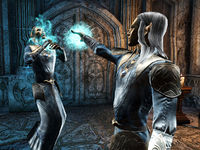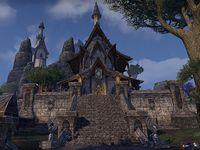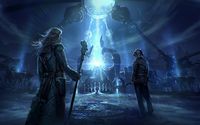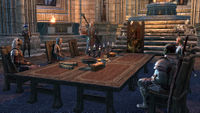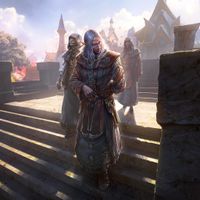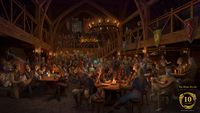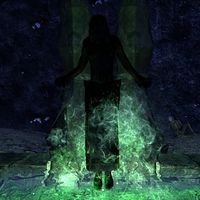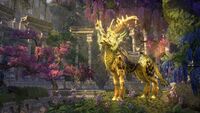Lore:Vanus Galerion
| Archmagister Vanus Galerion | |||
|---|---|---|---|
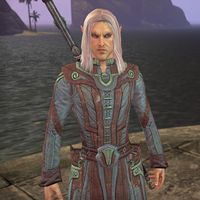 Archmagister Vanus Galerion circa 2E 582 Archmagister Vanus Galerion circa 2E 582
|
|||
| Race | Altmer | Gender | Male |
| Born | 2nd Era Sollicich-on-Ker, Summerset Isle |
||
| Resided in | Artaeum, Summerset Isle | ||
| Appears in | ESO, Legends | ||
—Vanus Galerion[1]
Archmagister Vanus Galerion (sometimes Galerion Vanus[2]), born as Trechtus, and called the Great Mage, was the founder of the Mages Guild and one of the most famous users of magic in the history of Tamriel.[3] By some accounts Galerion was the "quintessential mortal mage", his magical ability acknowledged even by the Daedra of Coldharbour, who believed his power could be used to complete the Planemeld in a matter of mere hours.[4][5] He trained with the Psijic Order along with fellow student Mannimarco. He strongly opposed Mannimarco's practice of necromancy, and would eventually lead an army of mages in a massive battle against Mannimarco's legions of undead, where he was killed.[1]
Contents
History[edit]
Early Life[edit]
"Trechtus" was born in the early years of the Second Era (roughly 600 years before the Alliance War)[6] in the Summerset Isles to serfs on the estate of a minor nobleman, Lord Gyrnasse of Sollicich-on-Ker. His father had secretly, against the law of Lord Gyrnasse, taught himself and then Trechtus to read. They had to rely on a black market to get around the restriction Gyrnasse put in place, but still managed to get a steady stream of books and scrolls. When Trechtus was eight, the smugglers were found and imprisoned. Some said that Trechtus's mother, an ignorant and religious woman fearful of her husband, was the betrayer of the smugglers, but there were other rumors as well. The trial of the smugglers was nonexistent, and the punishment swift. The body of Trechtus' father was kept hanging for weeks during the hottest summer Sollicich-on-Ker had seen in centuries.[3]
Three months later, Trechtus ran away, making it as far as Alinor, half-way across Summerset Isle. A band of troubadours found him nearly dead, curled up in a ditch by the side of the road. They nursed him to health, and employed him as an errand boy in return for food and shelter. One of the troubadours, a soothsayer named Heliand, who had trained as a mystic at Artaeum, recognized the boy's potential. When the troupe was performing in the village of Potansa on the far eastern end of Summerset, Heliand took Trechtus, then eleven, to Artaeum, where the Magister of the Isle, Iachesis, also recognized this potential and took Trechtus on as pupil, giving him the name of Vanus Galerion.[3]
At Artaeum[edit]
Vanus Galerion and Mannimarco were the most brilliant students in Artaeum at the time. While Galerion used his talents wisely and honorably, being described as having a "light and warm" heart, Mannimarco turned to the dark arts and was slowly corrupted by them, being noted as having a "dark and cold" heart. Galerion became aware of his contemporary's transformation, and confronted Mannimarco, enraged at the discovery their fellow students were being used as test subjects, however Mannimarco scoffed at Galerion's threats, and continued to study the dark arts. Eventually, Galerion confronted Mannimarco at Ceporah Tower, demanding that Mannimarco end his foul ways, but to no avail. Galerion informed the Psijic elders of his dicsovery and was nearly killed by the retaliation of Mannimarco, who remained unconcerned believing he'd simply be banished in the end. When the Psijic order banished Mannimarco to mainland Tamriel, Galerion realized that the necromancer would use the opportunity to amass a following there. The masters ignored Galerion's warnings about the terror they were releasing on the rest of Tamriel, a mistake that Galerion would not soon forget.[1][1][7][8]
After having many disagreements with the Psijics (though they were united in their hatred of necromancy), Galerion left Artaeum to pursue his dream: bringing the wondrous benefits of magic to the general public.[1][9]
Birth of the Guild[edit]
When he began collecting magic-users from around Summerset Isle, Galerion attracted the animosity of all. He was operating out of the urban center of Firsthold, and there was a common (and not entirely unfounded) attitude that magical experiments should be conducted only in unpopulated areas. Even more provocatively, Galerion proposed to make magical items, potions, and even spells available to any member of the general public who could afford to pay. No longer was magic to be limited either to the aristocracy or intelligentsia.[10] Some labeled Galerion's efforts "Galerion's Folly."[11]
In 2E 230,[12][UOL 1] less than a year after leaving Psijics, Galerion was brought before Iachesis, the King of Firsthold, Rilis XII,[12][1] and numerous nobles and members of the Psijic Order in the "Charter Conclave" to state the intentions of the fraternity he was forming.[11] Galerion's speech to Rilis and Iachesis was not recorded for posterity, but his charter, at any rate, was approved.[10] It proved to be extraordinarily successful, and Galerion himself would become very well-known for his wisdom. He's still cited as the authority on many magical concepts, such as trafficking with daedra,[13] and the modern schools of magic were developed by him.[9] He even outlawed the practice of necromancy within the Mages Guild, and classified the art of soul trapping into two categories: the legal, "White" souls consisting of lesser essences such as beasts and animals, and illegal "Black" souls derived from sentient beings. Galerion believed that such soul-trapping was a part of a sinister plot by Mannimarco to make necromancy seem commonplace and harmless.[14] He soon after formed the Order of the Lamp as protectors of the Guild.[10]
Before Mages Guild chapter houses had spread to the mainland of Tamriel,Vanus Galerion invented hyper powerful automated tools of alchemy and enchanting, so that anyone, no matter their own skill in the craft, could concoct whatever they wanted to. This was balanced by the fact that the cost in gold to create devices too dangerous were not affordable for the common man. Some few incidents occurred where some "unschooled yokels" invented things beyond their ken, such as the enchanting of the Daedric artifact Feyfolken. As an inevitability, Galerion later tore apart his tools, and created less powerful versions used within the guild for most of that institution's longevity.[15]
When Vastarie, a necromancer who had been a disciple in the Psijic Order alongside Galerion and had worked with Mannimarco to retrieve the first Black Soul Gems from Coldharbour, attempted to present the Sigil Geodes she'd invented to the fledgling guild, Galerion attended the demonstration.The geodes allowed for a soul to be captured upon the moment of death and than be interrogated for their knowledge at the mage's leisure, before being released or moved between crystals at will without the need of enchantment. Vastarie's invention is said to have left Galerion white faced with horror , and he departed after giving a furious and vindictive speech condemning the practice, with some among the assembled students following him.[16]
Disillusionment[edit]
—Vanus Galerion
Over time, Galerion grew bitterly disillusioned with the contrived hierarchies and sinister political environment that the Mages Guild had become. He grew regretful for establishing the guild in the first place, as it had become monster of its own, and was too late for him to fix. After denouncing the guild, Galerion elected to leave Tamriel entirely to travel to other lands. For many years Galerion wandered around Nirn. Eventually, after long his abandonment of the Mages Guild, Galerion claimed that he had found the virtue of magic in his solitary travels.[10][UOL 2] Despite this, Galerion still held the venerable title of Archmagister Emeritus, and influenced many of the Guild's affairs.[14] This hiatus would last for over a century, but he would eventually return to his duties as the Archmagister due to the crisis that would follow the Soulburst in 2E 578.[17]
Invasion from Coldharbour[edit]
Vanus Galerion became increasingly concerned about the activities of the Worm Cult and the looming threat of Molag Bal's Planemeld. In 2E 582, he and the Vestige attempted to negotiate a cease-fire in the Alliance War, so that the three alliances could commit their full resources to an assault on Coldharbour. This negotiation took place on the island of Stirk and was ultimately unsuccessful, but, after an attack by Molag Bal's forces, the alliances did endorse a smaller action, in which Mages Guild and Fighters Guild forces invaded Coldharbour to stop the Planemeld. Vanus personally opened the portal used to enter Coldharbour. [18][18][19]
During this invasion, Galerion was teleported outside the Black Forge of Coldharbour alone and attempted to disable it to help stop the Planemeld. He was soon captured by the Daedra, who intended to use him as a power source, believing that as the "quintessential mortal mage", the power raging inside Galerion would allow them to complete the forging of the Great Shackle and power it with Galerion's magic, thus allowing them to complete the Planemeld in mere hours instead of months. To prevent this outcome Galerion separated his being into its constituent essences of magicka, health and stamina, which the Daedra could not use to complete the Planemeld individually. Despite this, the overseers of the Black Forge imprisoned the separated essences and used them to power the Black Forge itself, using them to craft Dark Anchors and components of the Great Shackle, to power their Soul Shriven slaves so they'd keep working tirelessly, and to feed their vampiric servants. The Vestige freed him, restored and reunited his essence, and journeyed with him, when he personally destroyed the Great Shackle that was intended to bind Coldharbour and Nirn together by sending metaphysical chains across the planar chaos to latch onto the world.[4][20][21][5][18][19] Returning to command his forces from the Hollow City, the guilds crossed the Chasm of Coldharbour but were met by the vampires of the Orchard which were controlled by one of Molag Bal's Harvest Hearts. Vanus proposed enacting a ritual that would destroy the Heart and target the blood of all vampires connected to it, rendering them mindless and allowing the guilds to pass through. The vampire leader Virgar proposed using a method that would free the vampires from the Heart instead, allowing them to become allied to the guild forces.[18][19] It is unknown what the Vestige ultimately chose, but the vampires were severed from Molag Bal's control, allowing the guilds to enter the Reaver Citadel, which they captured to gain access to the Endless Stair. Then, along with the Vestige, Darien Gautier, Laloriaran Dynar, and Meridia, Vanus entered the planar vortex that was pulling Nirn into Coldharbour, and played a crucial role in its disruption by magically preparing the Light of Meridia that dispersed it alongside fellow guild mage Gabrielle Benele, ending the threat of the Planemeld.[18][19]
Rediscovery of Scribing and Guild Affairs[edit]
During this time, Ulfsild's Scribing, which was a lost art up until the time of the Three Banners War, was rediscovered by the Mages Guild's Order of the Lamp. Vanus Galerion was particularly enthusiastic of the possibilities it would open up, with early ideas being altars being installed in every guild hall, or that Scribing will perhaps one day be taught in the wilds.[22] The legacy of Ulfsild's lived on, with Scribing eventually evolving into the modern Spellcrafting systems.[UOL 3]
At this time, the Arch-Mage would also confront the warlock Carindon over his imprisonment of the Changeling Selene, an act which violated the accord that existed between Selene and the Mages Guild.[23] Around 2E 582, he enlisted the Vestige to help free Oracle Marieve from Mephala during the Daedric War. Galerion contacted the Vestige through the use of a Mages Guild Message Stone which conjured his projection. He enchanted a boat to take the Vestige to their destination and provided a summoning medallion which the Vestige could use to summon him to their location so that he could provide guidance during the investigation, but departed upon discovering that the Psijic Order was involved due to his bitter history with them. The guild also provided care for Marieve after she was rescued.[24]
Fate[edit]
And their power to me, and you shall live as befits the dead."
The hollow laugh of Mannimarco answered: "You die first."
—Mannimarco, King of Worms by Horicles
Sometime after 2E 582,[UOL 4] Galerion headed north with an army of Mages and Lamp Knights to a cursed mountain path to settle his business with Mannimarco. Galerion and his army were met by an equally powerful army of necromancers on the mountain, and both sides were ready to do battle.[1]
As the two armies clashed, lightning and frost cascaded around them. The necromancers summoned various undead creatures to their sides which were battered by streams of light forged by the battlemages. It is said that "with but a touch" Galerion "shook the mountain to its base" and the undead horde fell. However, heeding their dying cries the King of Worms, Mannimarco, finally emerged. Galerion noticed, than, that Mannimarco was no longer alive: he had turned himself into a lich, thus gaining immortality. It is said Mannimarco opened his maw and exhaled a miasma of darkness over the mountain, causing all present to feel the touch of death. Until, eventually, the Worm King's power failed and his artifacts were ripped from him, ending the battle. For a long time Mannimarco was thought to have died in the battle. Although Galerion himself was killed, Mannimarco clung to his state of undeath, and the practice of necromancy would live on. Mannimarco's followers were either killed or scattered, and the triumphant army Galerion left behind secured his legacy and the legacy of the Mages Guild.[1] Following the battle, Galerion may have been raised from the dead to serve as one of Mannimarco's Worm Thralls for some time.[25]
Galerion's visage was later captured in a morbid one hundred foot tall statue inside Scourg Barrow, constructed of decayed bodies and bones.[UOL 5]
Contributions to Magical Research[edit]
Some sources claim that the praxes and rituals used by all modern potionmakers, itemmakers, and spellmakers were originally codified by Vanus Galerion. Galerion is said to have restructured the schools of magic so they'd be understandable by the masses and to have invented the tools of alchemy and enchanting so everyone could concoct whatever they wanted without fears of magical backfire. It is said that the original tools of enchanting and alchemy that Galerion crafted were more automated than modern ones, robotic master enchanters and alchemists that could create anything the customer asked for as long as they paid for it and could be used for that purpose by any layman, even without any understanding of magic. Even an enchanted sword that could "cleave the world in twain" is said to have been theoretically possible to make through these original tools, obstructed only by the enormous cost in magicka and gold. This level of accessibility is said to have resulted in a number of incidents where laymen created dangerous arcane objects beyond their ken. Galerion is said to have eventually realized the danger his original enchanting and alchemy tools posed, and to have had them destroyed and replaced by less automated versions which required users to have some understanding of what they were doing to use them. Because of these contributions to making the study of magic more accessible and free, Galerion is described in some sources as the originator of the practice of magic in its modern form.[15]
By some accounts Galerion was responsible for codifying the division between "Black", or illegal to use, and "White", or legal to use, souls during the Interregnum. In an effort to combat the spread of Soul Trapping and Soul Gems, which had become ubiquitous across every market and bazaar, Galerion co-opted the practice by restricting the Soul Trapping spells that would be taught only to those that'd imprion souls the guild approved of, thus codifying the division between black and white souls.[14] Some sources also credit Galerion with codifying the schools of magic,[9] though others credit Shalidor, or the Shad Astula school of magic, with their creation instead.[26][27]
Galerion is also known to have written works on the fundaments of the discipline of traffic and commerce with Daedra Lords, with his texts being cited by other scholars as an important resource for students interested in learning more about the esoteric but well established practice.[13]
By his own account Galerion had a preference for shock magic over other elemental applications of the school of Destruction, and considered shock the element which a true scholar would give pride of place to in his grimoire, owing to its greater ease of use and more varied applications. He wrote a text listing some of the additional uses of shock magic, such as shrouding the caster in a lightning cloak, placing explosive runes upon surfaces, or "riding the lightning" to appear instantly where the bolt landed, in an attempt to promote the use of the element.[28]
Gallery[edit]
Notes[edit]
- Though Vanus Galerion is credited as creating the schools of magic in The Black Arts On Trial, the book Proposal: Schools of Magic has the scholar Gabrielle Benele propose to adopt the schools of magic from Shad Astula within the Mages Guild, a suggestion which Vanus rejects repeatedly. A Minor Maze attributes them to Shalidor.
- Many principles of magic are named after Galerion. In Skyrim, Wylandriah makes reference to "Galerion's Law of Casting". Ancotar's Journal mentions how "Galerion's Ninth Law" being immutable derailed a magical experiment attempting to spontaneously generate life.
- Vanus also appeared in the book "I was Summoned by a Mortal," where he summons the book's author, Kynval Zzedenkathik, to fight against Worm Cultists, much to the Kynval's dismay.
- A fabled golden Indrik is rumoured to have once served as Galerion's companion. It is said the creature's rider would see a world full of shimmering ideas and possibilities.[30]
- A statue of him appears in the city of Cheydinhal in Oblivion.
- Vijay Lakshman participated in the Dungeons & Dragons homebrew campaign ran by Julian Lefay during Daggerfall's development about the Camoran Usurper, playing the character of Vanus Galerion, who was later immortalized in Daggerfall lore books with a full backstory.[31]
See Also[edit]
Books[edit]
- Artaeum Lost by Vanus Galerion — A short biography of Vanus Galerion's early life
- Galerion the Mystic by Asgrim Kolsgreg — A biography of Galerion, a Psijic who founded the Mages Guild
- Guild Memo on Soul-Trapping by Vanus Galerion, Archmagister Emeritus — Vanus Galerion's proposal on the use of soul-trapping magics
- On the Utility of Shock Magic by Vanus Galerion — Archmage Galerion's notes on the flexibility of shock magic
- Origin of the Mages Guild by The Archmage Salarth — Where and how the Mages Guild started
- Mannimarco, King of Worms by Horicles — Biography of Mannimarco, the leader of Necromancers, in verse
References[edit]
- ^ a b c d e f g h Mannimarco, King of Worms — Horicles
- ^ Research Notes quest in Daggerfall
- ^ a b c Galerion the Mystic — Asgrim Kolsgreg
- ^ a b The Source of Power
- ^ a b Galerion's Health dialogue ESO
- ^ Emmandic Oltz's dialogue in ESO
- ^ EGT — Flaccus Terentius, 2E 581
- ^ Vanus Galerion's dialogue during Half-Formed Understandings in ESO
- ^ a b c The Black Arts On Trial — Hannibal Traven, Archmagister of the Mages Guild
- ^ a b c d Origin of the Mages Guild — The Archmage Salarth
- ^ a b Kinlord Rilis and the Mages Guild — High Incunabulist Valaste of the Mages Guild
- ^ a b Mages Guild Charter
- ^ a b Liminal Bridges — Camilonwe of Alinor
- ^ a b c Guild Memo on Soul-Trapping — Vanus Galerion, Archmagister Emeritus
- ^ a b Feyfolken — Waughin Jarth
- ^ The Legend of Vastarie — Afwa, a Student and Friend
- ^ Loremaster's Episode of ESO-RP ZOS Interview
- ^ a b c d e Events of ESO
- ^ a b c d Vanus Galerion's dialogue in ESO
- ^ Galerion's Magicka dialogue ESO
- ^ Galerion's Stamina dialogue ESO
- ^ Loremaster's Archive - Scribing — Votary Nahila
- ^ Allanwen's dialogue ESO
- ^ Vanus Galerion's dialogue during Through a Veil Darkly in ESO
- ^ Mannimarco's dialogue in Oblivion
- ^ A Minor Maze
- ^ Proposal: Schools of Magic — Gabrielle Benele, Daggerfall Mages Guild
- ^ On the Utility of Shock Magic — Vanus Galerion
- ^ Oblivion Prima Guide
- ^ Galerion's Indrik's description in ESO
- ^ Interview with Ted Peterson by Indigo Gaming
Note: The following references are considered to be unofficial sources. They are included to round off this article and may not be authoritative or conclusive.
- ^ Xanathar's Library Archive/History
- ^ Ted Peterson's posts in Masser and Secunda
- ^ ESO 2024 Global Reveal
- ^ Lawrence Schick's Posts discussing why Vanus and Mannimarco never interact during ESO
- ^ Ted Peterson's posts in War of the Wormgod
